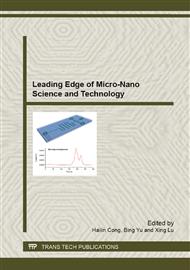p.99
p.103
p.108
p.115
p.119
p.124
p.131
p.138
p.144
The pH Influence on the Preparation of Hollow Fe2O3 Spheres by Hydrothermal Method
Abstract:
In this paper Fe2O3 precursor coating on the surface of carbon balls was prepared by hydrothermal method using Fe(NO3)3·9H20 and glucose as the raw materials. After calcination Fe2O3 hollow sphere could be achieved. The influence of pH value on the preparation of hollow Fe2O3 spheres was studied using XRD and SEM respectively. The results show that the pH value has no effect on the formation of Fe2O3 phase, but has a giant influence on the morphology of the hollow spheres. The Fe2O3 hollow spheres were achieved when the pH value was between 3 and 7. The particles with sheet and block structure form when pH7. The mechanism was studied, When 3
Info:
Periodical:
Pages:
119-123
Citation:
Online since:
March 2013
Authors:
Keywords:
Price:
Сopyright:
© 2013 Trans Tech Publications Ltd. All Rights Reserved
Share:
Citation:


